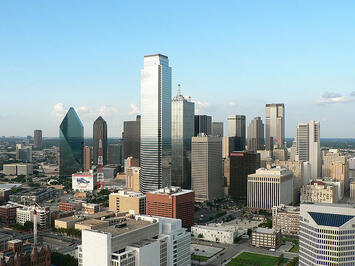
Located on the Southern Plains, far from America’s coasts and great river systems, the Dallas–Fort Worth metropolitan area epitomizes the new trends in American urbanism. Over the past decade, DFW has grown by some 1.3 million people, to reach a population of just under 7.7 million, making it the nation’s fourth-largest metro, based on new figures from the 2020 census. Rather than building on natural advantages, the metroplex owes its tremendous growth to railroads, interstate highways, and airports, plus an unusual degree of economic freedom and affordability.
There’s an adage in Texas about a braggart being someone who’s “all hat and no cattle.” But you can’t say that about “Big D,” rapidly emerging as the de facto capital of the American Heartland. The DFW metroplex is now home to 24 Fortune 500 company headquarters, trailing only New York and Chicago; 40 years ago, the region had fewer than five. DFW’s economy has grown markedly faster than those of its three largest rivals (New York, Los Angeles, and Chicago), and it has come through the Covid-19 pandemic with less employment loss than any other metro among the nation’s 12 largest.
Population, too, has surged almost three times faster than the average for the nation’s 50 largest metros. Much of this growth has come from net domestic migration: among America’s top 20 metros, DFW boasts the fourth-highest rate of net inbound migration (including millennials), and the area has experienced a massive surge in its foreign-born population. Demographers project that DFW will reach 10 million people sometime in the 2030s, surpassing Chicago to become America’s third-largest metro area.
Dallas–Fort Worth is emerging as a megacity but a distinctly polycentric one—more like Los Angeles than New York or Chicago. As of 2017, the Dallas central business district contained only 11 percent of DFW’s total office space and only 5.2 percent of the region’s office space under construction. Even including Fort Worth’s smaller downtown, the area has a smaller share of its office space in traditional downtowns than almost any other large American city. Since 2010, more than 87 percent of the metro area’s population growth has been outside the city of Dallas, as has virtually all the region’s job growth. That growth has been concentrated in two corridors: one stretching from the northern suburbs almost to the Oklahoma border; and another radiating outward from downtown Fort Worth.
At the same time, some of the region’s core urban areas, particularly Southern Dallas, continue to struggle. If DFW is really going to vault into the ranks of top-tier global cities, it will need to offer not just suburban safety and quality of life but also more options for those who want to live in a traditional urban setting, as well as better economic opportunities for residents of neighborhoods that have been left behind.
Farmer and lawyer John Neely Bryan founded Dallas in 1841, when he claimed a plot of land on an eastern bluff overlooking the Trinity River. Settled after the Civil War by Confederate veterans (Bryan himself served as a Confederate soldier) and freed slaves, the Dallas–Fort Worth area unequivocally belonged to the South in its attitudes and social relations up to the early twentieth century.
Between 1880 and 1900, the city of Dallas grew fourfold, exceeding 40,000 in population, based on its position as a railroad junction and a cotton-trading hub. Fort Worth, meantime, boomed in the late nineteenth century as a key stop on the great Western cattle drives. Early on, the region developed a reputation as a violent, riotous place—a Wild West outpost known for spawning legendary figures from Doc Holliday to Bonnie and Clyde, as well as carousing cowhands and other unsavory sorts.
In the early twentieth century, the Texas oil boom raised the region’s profile, making Dallas a local financial center. Still, the state’s economy depended on resource extraction, an industry controlled by the big eastern cities. Texas remained, in the words of governor (and Dallasite) Pappy O’Daniel, “New York’s most valuable foreign possession.”
But even as they genuflected eastward, the young city’s business leaders had big plans and a talent for self-promotion. As Fortune observed in 1949, “Dallas doesn’t owe a thing to accident, nature, or inevitability. . . . It is what it is . . . because the men of Dallas damn well planned it that way.” Starting in the 1930s, the Dallas Citizens Council, a business group representing what historian Darwin Payne has called “the local oligarchy,” remade the city, building parks and cultural institutions, promoting the growth of Southern Methodist University, and creating annual tourist attractions—especially the State Fair of Texas and the Cotton Bowl college football classic.
Their efforts paid off. New York travel writer John Gunther dismissed Houston as uncouth and money-obsessed in a 1946 profile but praised Dallas as “a highly sophisticated little city,” with fine hotels, restaurants, and department stores, epitomized by Neiman Marcus. Gunther described downtown Dallas as “a mini-Manhattan.”
Read the rest of this piece at City Journal.
Joel Kotkin is the author of The Coming of Neo-Feudalism: A Warning to the Global Middle Class. He is the Presidential Fellow in Urban Futures at Chapman University and Executive Director for Urban Reform Institute. Learn more at joelkotkin.com and follow him on Twitter @joelkotkin.
J.H. Cullum Clark is Director, Bush Institute-SMU Economic Growth Initiative and an Adjunct Professor of Economics at SMU. Within the Economic Growth Initiative, he leads the Bush Institute’s work on domestic economic policy and economic growth. Follow him on Twitter @cullumclark.
Photo credit: fcn80, via flickr under CC BY-SA 2.0 License.












